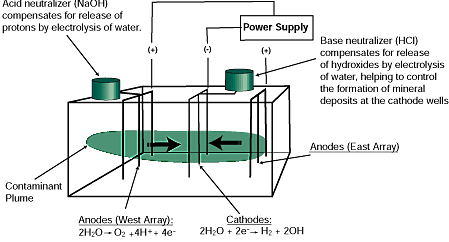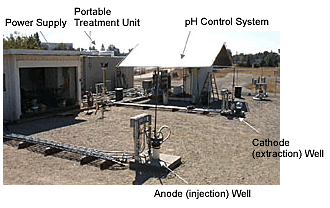|

Boosting
pump-and-treat with electro-osmosis
Lawrence Livermore National Laboratory
developed and is deploying a low-energy technology that serves as
the first step in a Phased Source Remediation (Tech
ID 2923)—an approach that seeks to lower remediation costs
by first using less expensive technologies for starving a plume at
its source before turning to progressively higher energy approaches.
Electro-osmosis, in combination with hydraulic pumping, is being used
to increase the rate of groundwater flow through extraction wells
to a portable treatment unit on the surface, which is removing chlorinated
hydrocarbons by air-stripping with activated carbon adsorption. In
this Accelerated Site Technology Deployment project, investigators
are assessing how electro-osmosis can be used to enhance a pump-and-treat
remediation. The Subsurface Contaminants Focus Area is helping to
fund this ASTD project.

LLNL’s Environmental Restoration Division is deploying electro-osmosis
at a site near a helicopter pad and across from the National Ignition
Facility, which is under construction. Fine-grained, low-permeability
sediments in the saturated zone are contaminated with chlorinated
hydrocarbons, primarily TCE, at relatively high concentrations from
5 to 10 ppm. This environment is difficult to remediate due to the
clay soil’s retention of groundwater. The average flow rate to
wells in the area is less than 0.5 gallons per minute. Electro-osmosis’
role is to overcome the soil’s tight grip on groundwater and
increase the rate of groundwater flow toward cleanup.
Investigators have applied an electric field below ground through
an array of nine electrode-bearing groundwater wells. Pore water,
which is locally positively charged in the vicinity of negatively
charged clay mineral surfaces, is induced to flow away from the positively
charged anodes wells located on either end of the array toward the
extraction wells in the center of the array that contain the negatively
charged cathodes.
The system also includes buffering tanks at the surface to maintain
pH neutrality during electrolysis reactions at both types of electrodes.
pH control is necessary to prevent the formation of mineral deposits
at the cathodes and acidification of the sediments near the anodes,
which would cause a corresponding reduction in electro-osmotic conductivity.

After the use of electro-osmosis to expedite the extraction of water
through wells, the water is sent to the portable treatment unit where
the chlorinated hydrocarbons are removed. The water is then returned
to the subsurface through the anode wells. Support equipment includes
submersible pumps, water-level sensors, and flow meters for each well,
along with a manifold assembly that directs the flow of water between
extraction wells, pH adjustment units for the cathode and anode arrays,
a water treatment facility, and injection wells. Geokinetics
International, Inc. of Berkeley, California, supplied equipment
and support for the project.
Preliminary results indicate that electro-osmotic pumping is leading
to a measurable increase in contaminant extraction rates. Analysis
of these initial data, coupled with flow and transport modeling, suggest
significant reductions in the time required to remediate the site
as opposed to an exclusive pump-and-treat approach. Currently, the
system is being upgraded to allow for more reliable long-term operation.
For more information about this project, contact Bob Bainer at
bainer1@llnl.gov.
|